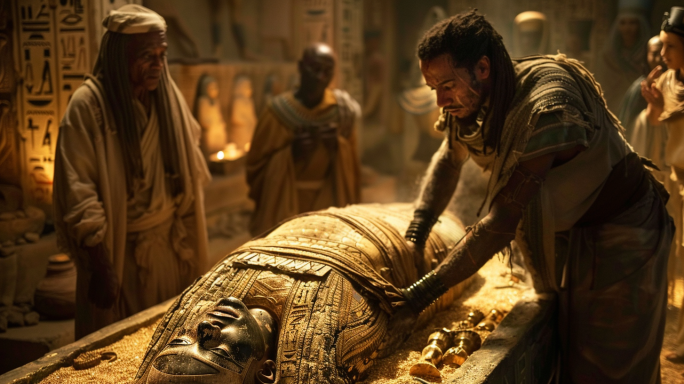Introduction
The ancient Egyptian art of mummification is one of the most fascinating aspects of their culture, reflecting their beliefs in the afterlife and the meticulous care they took to preserve the dead. This process involved a detailed and complex series of steps, utilizing various materials to ensure the body was well-preserved for the journey to the afterlife. Let’s explore the key ingredients and methods used in this intricate process.
The Importance of Mummification
Beliefs in the Afterlife
Ancient Egyptians believed that preserving the body was essential for the deceased to transition successfully into the afterlife. They thought the physical body would be reunited with the soul, or “ka,” thus requiring meticulous preservation.
Ritual Significance
Mummification was not just a physical process but also a spiritual one. It involved rituals and prayers to protect the deceased and ensure a safe passage to the afterlife.
The Mummification Process
Step-by-Step Procedure
The mummification process typically took around 70 days and was carried out by skilled embalmers. The steps included washing and purifying the body, removing internal organs, drying the body with natron, anointing it with oils, and finally, wrapping it in linen.
Key Materials Used
Several materials were essential for making a mummy, each serving a specific purpose in the preservation process.
Natron: The Drying Agent
What is Natron?
Natron is a naturally occurring salt mixture composed primarily of sodium carbonate decahydrate and sodium bicarbonate. It was abundant in ancient Egypt, particularly around the Nile Delta.
Role in Mummification
Natron played a crucial role in dehydrating the body. The embalmers would pack the body and internal cavities with natron, which absorbed all moisture, effectively preventing decomposition.
Resins and Oils: Protection and Perfume
Types of Resins and Oils
The embalmers used various resins, such as myrrh, frankincense, and cedar oil, known for their antibacterial properties. These substances were applied to the body to protect it from decay and add a pleasant fragrance.
Application Process
After the body was dried, it was coated with these resins and oils. This not only helped in preserving the body but also symbolized purification and sanctity.
Linen Strips: Wrapping the Body
Quality and Quantity of Linen
Linen, made from flax plants, was the primary material used for wrapping the mummy. The quality and amount of linen varied depending on the deceased’s social status. Wealthier individuals could afford finer and more substantial linen wrappings.
Wrapping Technique
The wrapping process was intricate, with embalmers carefully wrapping each part of the body separately before covering the entire body in several layers of linen. This provided additional protection and structural integrity.
Amulets: Spiritual Protection
Types of Amulets
Amulets were small charms placed between the layers of linen during the wrapping process. They came in various shapes and materials, each holding specific meanings and protective properties. Common amulets included the Ankh (symbol of life), the Eye of Horus (protection), and the Scarab (rebirth).
Placement of Amulets
The placement of amulets was deliberate, with each positioned to protect different parts of the body and aid the deceased in the afterlife. The embalmers recited prayers and spells to activate the amulets’ powers.
Additional Materials and Tools
Canopic Jars
The internal organs removed during mummification were not discarded but preserved in canopic jars. Each jar was dedicated to a specific organ and protected by one of the Four Sons of Horus.
Mummification Tools
The embalmers used various tools for different tasks, such as evisceration hooks for removing internal organs, and needles for stitching incisions. These tools were often made from bronze or obsidian.
The Final Resting Place
Sarcophagi and Coffins
Once the mummification process was complete, the mummy was placed in a decorated coffin or sarcophagus. These containers were often elaborately designed with inscriptions and artworks depicting scenes from the deceased’s life and the afterlife.
Tomb Preparations
The tomb itself was prepared with care, stocked with items the deceased might need in the afterlife, such as food, clothing, and treasures. The walls of the tomb were often adorned with hieroglyphs and paintings narrating the deceased’s journey to the afterlife.
Conclusion
The ancient Egyptian mummification process was a sophisticated and spiritual practice that ensured the deceased’s body was preserved for eternity. Using materials like natron, resins, oils, linen, and amulets, the embalmers created mummies that have lasted thousands of years, providing invaluable insights into ancient Egyptian culture and beliefs. This meticulous preservation underscores the Egyptians’ profound respect for the dead and their unwavering belief in the afterlife.
FAQs
1. What was the primary purpose of mummification in ancient Egypt?
The primary purpose of mummification was to preserve the body for the afterlife, ensuring it remained intact for the deceased’s soul to recognize and reunite with.
2. How long did the mummification process take?
The mummification process typically took around 70 days, involving various stages of purification, drying, anointing, and wrapping.
3. What role did natron play in mummification?
Natron, a naturally occurring salt, was used to dry out the body by absorbing moisture, which prevented decomposition.
4. Why were amulets placed within the linen wrappings of a mummy?
Amulets were placed within the linen wrappings for spiritual protection, each amulet symbolizing different aspects of protection and aiding the deceased in the afterlife.
5. What was the significance of canopic jars?
Canopic jars were used to preserve the internal organs removed during mummification. Each jar protected a specific organ and was associated with one of the Four Sons of Horus.

